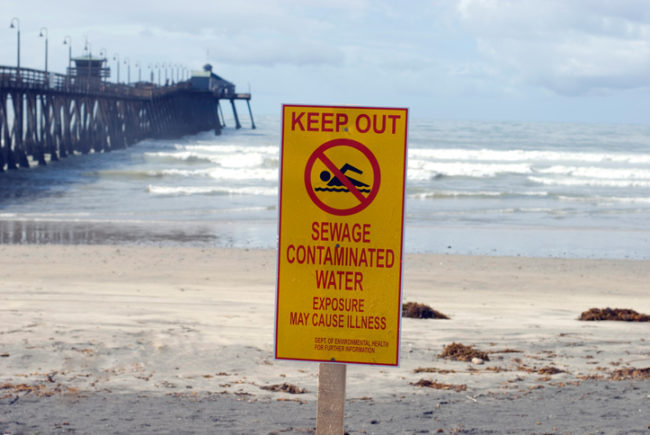SoCal surfer dudes were in for a surprise when a serious funk rolled in with the tides in Imperial Beach and Chula Vista, California. A new lawsuit has been filed against the International Boundary & Water Commission – United States Section (IBWC or the Commission) and Veolia Water North America West for repeatedly failing to address “devastating pollution discharges” from the Tijuana River, which had been used as a dump for decades.
In the last three years alone, severely polluted waters have caused officials in this Southern California community to close their beaches in excess of 500 days. There have been 28 beach closures since January 1, 2018 alone, and 376 documented sewage spills since 2015. In February of 2017, during repairs to the sewage collection system in central Tijuana, an estimated 28 million gallons of untreated sewage were discharged into the Tijuana River which outlets to the Pacific Ocean. Frustrations in the region have led to a battle in the courts between California municipalities and the Federal Government, alleging violations of the Clean Water Act and the Resource Conservation and Recovery Act.
For years, residents of nearby towns have claimed that the International Boundary & Water Commission has failed to ensure that its contractor, Veolia Water North America West, properly operates and maintains the South Bay International Wastewater Treatment Plant. The plant is supposed to prevent pollution from the Tijuana River from entering United States waters. However, since 1993, pollution from the river has been so pervasive that the county of San Diego has been continuously declaring states of emergency due to raw sewage in its waterways.
In September 2017, Imperial Beach, along with the city of Chula Vista and the Port of San Diego, filed an intent to sue the Commission and Veolia Water North America-West, with hopes of spurring action from the allegedly responsible entities. The IBWC was formed in 1889, and is made up of officials from the State Department of the United States and the Secretariat of Foreign Relations of Mexico, who are jointly responsible for border water quality problems, among other issues. The IBWC responded to the intent to sue, stating that they could not commit funds toward water treatment without approval of the State Department and Congress, and that they were not legally required to monitor trash and sewage effluence from Mexico.
Surfers and recreationalists are fed up, noting that sewage odor is on the beach and pollution can be seen floating on the water. With no immediate solution in sight, a lawsuit was filed on March 2, 2018 in the U.S. District Court for the Southern District of California.
The Cities’ complaint alleges that, “Human sewage, enormous volumes of sediment, industrial wastes, pesticides, massive amounts of trash, and a host of other nefarious pollutants from defendants’ facilities barrage the Tijuana River, its estuary, the Pacific Ocean, and the Imperial Beach beachfront, contaminating those natural resources, stigmatizing the beachfront as unclean and unsafe, and sickening members of the public who use the Tijuana River Valley, the beach, and the ocean for recreation.”
With a population of 1.6 million people, Tijuana is one of Mexico’s largest cities, and it carries all the practical problems of a major metropolis, coupled with an aging infrastructure and lax environmental regulations. Mexico lacks the toxic waste guidelines of the United States, and it is not uncommon for lead, pesticides, trash, batteries, and other chemicals to be disposed of in border canyons and waterways, which drain to the Tijuana River and its estuary, and eventually the Pacific Ocean, fouling the beaches of Southern California.
In December, IBWC held a meeting with Imperial Beach and San Diego authorities to discuss the issue. The San Diego County Regional Water Quality Control Board called for building a number of projects to address the water pollution, including infrastructure to divert flows from the Tijuana River to the nearby International Wastewater Treatment Plant located west of San Ysidro. In response, the IBWC proposed focus groups and studies, which residents feel do not go far enough to immediately address the problem of the polluted waterfront.
The lawsuit seeks to force the International Boundary and Water Commission’s U.S. section to meet its obligations under the federal Clean Water Act to treat the runoff from Tijuana. Whether or not the funds can be obtained, the legal action against the IBWC and Veolia Water North America West demonstrates that tides are turning against perceived inaction by government agencies on environmental issues.
As the Clean Water Act provides guidelines for regulating the discharge of pollutants into waters of the United States, and the Resource Conservation and Recovery Act provides a framework for national control of solid waste disposal, the litigation strategy will be interesting to observe and is sure to draw the attention of both environmentalists and politicos in the US and Mexico.

